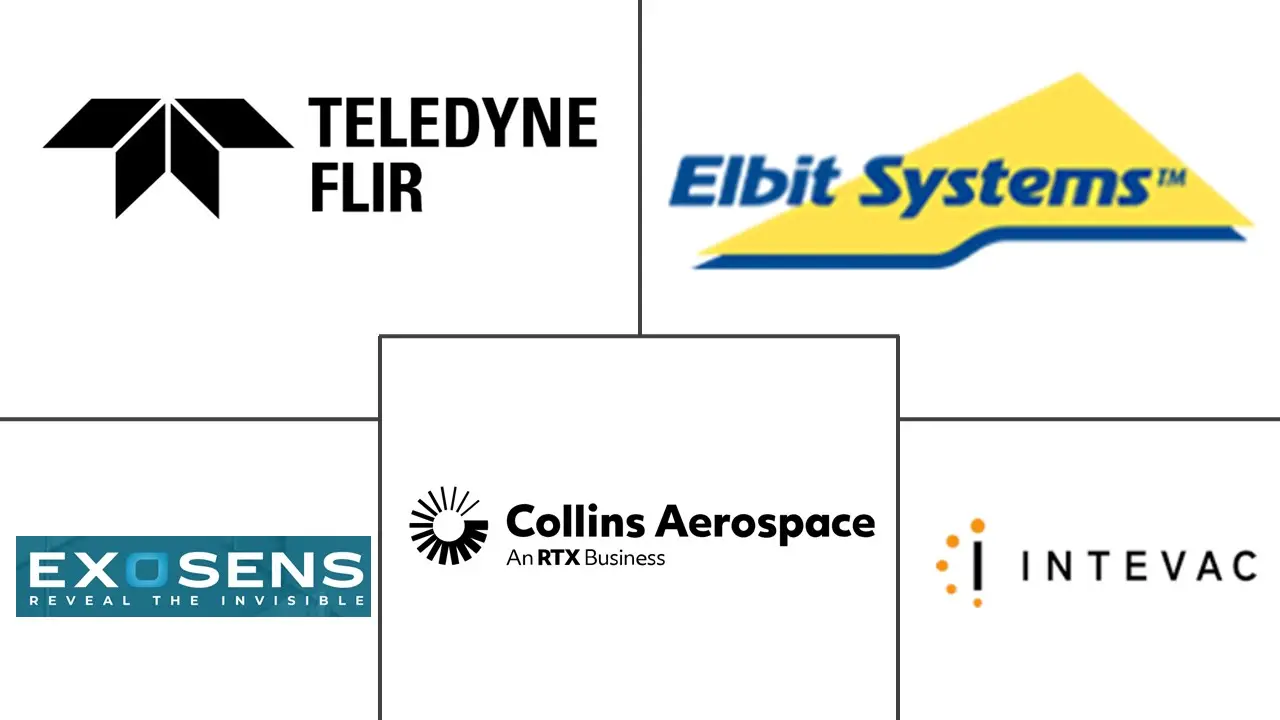Night Vision Cameras Market Size and Share
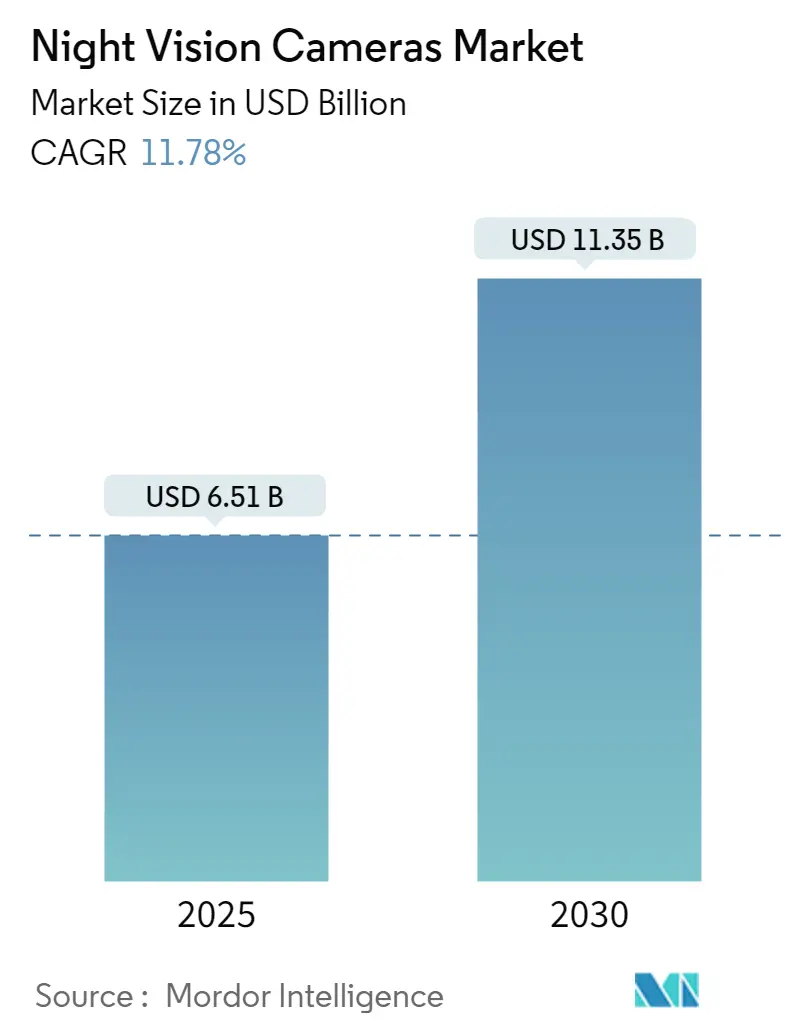
Night Vision Cameras Market Analysis by Mordor Intelligence
The Night Vision Cameras Market size is estimated at USD 6.51 billion in 2025, and is expected to reach USD 11.35 billion by 2030, at a CAGR of 11.78% during the forecast period (2025-2030).
The night vision devices industry is experiencing significant transformation driven by escalating cross-border security concerns and illegal migration challenges. According to the European Border and Coast Guard Agency (FRONTEX), attempts to illegally cross the external borders of the European Union increased by 17% in 2023, reaching approximately 380,000 cases. This surge in illegal border activities has prompted security agencies worldwide to adopt advanced surveillance technologies, including night vision cameras equipped with artificial intelligence capabilities. The integration of these technologies enables enhanced monitoring capabilities in low-light conditions, providing security forces with crucial tactical advantages in border protection and surveillance operations.
The integration of artificial intelligence and machine learning technologies is revolutionizing night vision camera capabilities and applications. Modern night vision systems now incorporate features such as computer vision, automatic threat detection, and real-time data analysis capabilities. For instance, in January 2024, Hanwha Vision introduced an AI-driven radiometric thermal imaging camera series that seamlessly integrates cutting-edge artificial intelligence with temperature detection and high-performance imaging. These advanced systems can penetrate through darkness and inclement weather, ensuring clear visuals for safe navigation and monitoring, particularly in nighttime or low-visibility scenarios.
The residential security segment is witnessing substantial growth, driven by increasing consumer adoption of smart home technologies and security systems. According to the Consumer Technology Association (CTA), smart home device sales revenue in the United States reached USD 23.5 billion in 2023, reflecting growing consumer interest in advanced home security solutions. This trend is particularly significant given that the United States reports more than 580,000 break-ins annually, according to Securiteam, driving homeowners to invest in sophisticated surveillance systems including night vision security cameras for enhanced security.
Environmental monitoring and wildlife conservation applications are emerging as significant growth areas for night vision technology. Conservation organizations and research institutions are increasingly deploying night surveillance cameras for wildlife monitoring, anti-poaching operations, and ecological research. In February 2024, forest officials in Hyderabad, India, successfully apprehended Nilgai poachers using night vision camera traps set up at Amrad Tiger Reserve, demonstrating the technology's effectiveness in wildlife protection. The integration of thermal imaging camera capabilities with traditional night vision technology is enabling researchers and conservationists to conduct non-invasive monitoring of nocturnal wildlife behavior and protect endangered species more effectively.
Global Night Vision Cameras Market Trends and Insights
Increasing Military Expenditure
The substantial rise in global military expenditure has emerged as a primary driver for the military night vision devices market, with countries worldwide increasing their defense budgets to equip their forces with advanced technological capabilities. According to recent data, global military spending reached USD 2,240 billion in 2022, showing a significant increase from USD 1,807 billion in 2017. This surge in military spending is reflected in major defense contracts, such as the November 2023 agreement between Night Vision LLC and the U.S. Department of Defense worth USD 500 million for supplying Squad Binocular Night Vision System Goggle systems to enhance U.S. Marine Corps capabilities. Similarly, in January 2024, the Organization for Joint Armament Cooperation (OCCAR-EA) signed a contract with Hensoldt Optronics GmbH and THEON Sensors SA for additional procurement of night vision device goggles for Belgium and Germany's armed forces.
The increasing global security threats and geopolitical tensions have prompted nations to prioritize military modernization, leading to substantial investments in military night vision technology. For instance, according to NATO data, the United States allocated approximately USD 860 billion for defense spending in 2023, while other major NATO members like Germany and the United Kingdom committed USD 68.08 billion and USD 65.76 billion, respectively. These investments are primarily directed towards enhancing military capabilities through advanced technologies, including night vision devices that enable armed forces to operate effectively in low-light conditions and maintain tactical advantages during nighttime operations. The ongoing conflicts and border disputes worldwide have further emphasized the critical importance of military night vision technology in modern military operations, driving continued investment in these capabilities.
Increasing Adoption from Law Enforcement
Law enforcement agencies worldwide are increasingly incorporating night vision devices into their operational capabilities, driven by the rising challenges of cross-border terrorism, illegal migration, and sophisticated criminal activities. According to the European Border and Coast Guard Agency (Frontex), 2023 witnessed a 17% increase in attempts to illegally cross the external borders of the European Union compared to the previous year, reaching approximately 380,000 attempts. This escalating challenge has prompted law enforcement agencies to enhance their surveillance capabilities through advanced night vision system technology, enabling effective monitoring and response during nighttime operations. The integration of night vision devices has become crucial for law enforcement agencies to maintain border security, prevent unauthorized entries, and combat various forms of transnational crimes.
The evolution of infrared camera technology, particularly in terms of enhanced image quality, reduced size, and improved durability, has made these devices increasingly attractive for law enforcement applications. Recent technological advancements have led to the development of more sophisticated and user-friendly systems, as exemplified by Consistent Infosystems' January 2024 launch of their new surveillance camera range in India, featuring advanced capabilities such as smart Wi-Fi app control and enhanced night vision functionality. These innovations have enabled law enforcement agencies to conduct more effective surveillance operations, particularly in challenging low-light conditions. The ability to obtain clear footage and maintain continuous monitoring capabilities, regardless of lighting conditions, has made thermal imaging cameras an indispensable tool for modern law enforcement operations, from routine patrols to specialized tactical operations.
Segment Analysis: By Type
Camera Segment in Night Vision Devices Market
The camera segment continues to dominate the global night vision devices market, commanding approximately 34% market share in 2024. This significant market position is driven by the widespread adoption of night vision cameras across various applications, including security surveillance, military operations, and wildlife monitoring. Night vision cameras have become essential tools for enhancing video surveillance systems in low-light situations, with their IR illumination capabilities being crucial for conducting surveillance during nighttime. These cameras enable the safeguarding of valuable assets by capturing video evidence of vandalism, theft, and unauthorized activities in low-light conditions, offering capabilities that conventional security systems cannot match. The segment's leadership is further strengthened by the increasing integration of advanced features such as high-resolution imaging, motion detection, and wireless connectivity options.
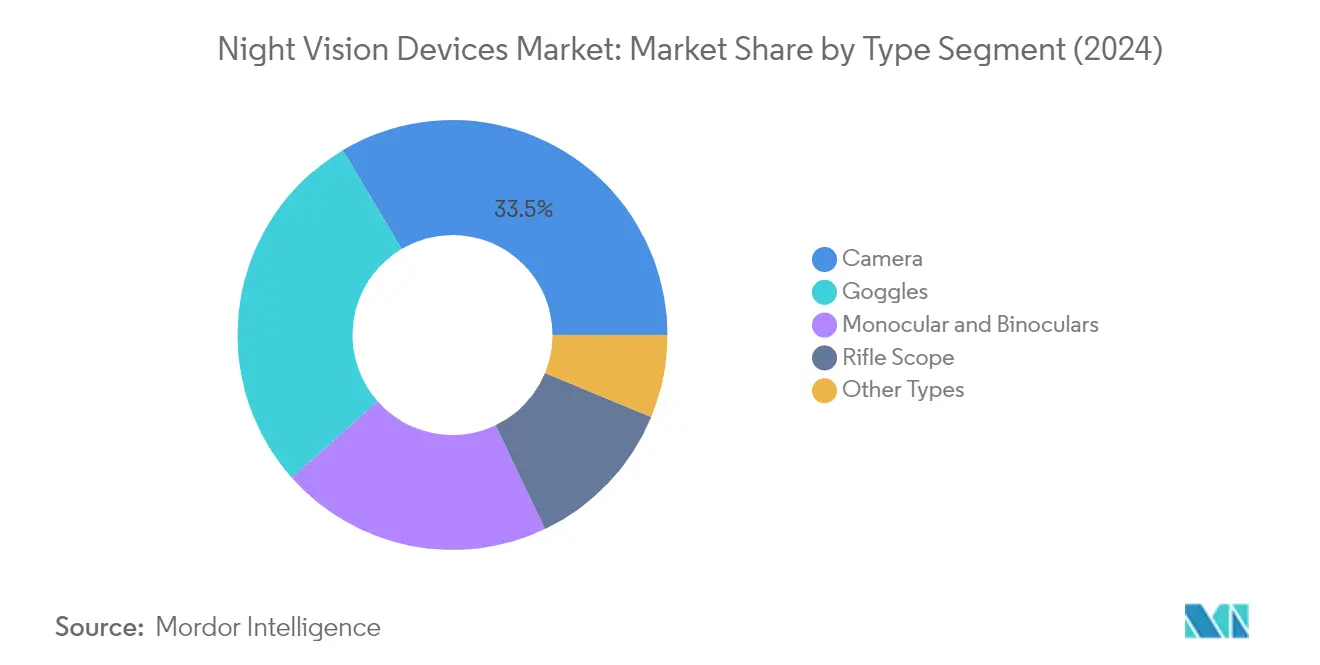
Goggles Segment in Night Vision Devices Market
The goggles segment is projected to exhibit the highest growth rate in the night vision devices market, with an expected CAGR of approximately 9% during the forecast period 2024-2029. This robust growth is primarily attributed to the increasing adoption of night vision goggles in military and law enforcement applications, where they serve as crucial tools for nighttime operations and surveillance. The segment's growth is further fueled by technological advancements such as the integration of thermal imaging capabilities, enhanced image resolution, and improved ergonomic designs. Modern night vision goggles are becoming increasingly sophisticated, offering features like auto-gating, superior depth perception, and compatibility with various mounting systems, making them indispensable for military personnel, law enforcement officers, and security professionals operating in low-light conditions.
Remaining Segments in Night Vision Devices Market by Type
The remaining segments in the night vision devices market include monocular and binoculars, rifle scope, and other types, each serving specific applications and user requirements. The monocular and binoculars segment plays a crucial role in surveillance, wildlife observation, and security applications, offering portable and versatile solutions for night vision requirements. The rifle scope segment caters primarily to military, hunting, and tactical applications, providing precision targeting capabilities in low-light conditions. The other types segment encompasses various specialized night vision devices such as helmet-mounted systems and pathfinders, contributing to the market's diversity and addressing niche application requirements across different sectors.
Segment Analysis: By Technology
Thermal Imaging Segment in Night Vision Devices Market
The thermal imaging segment has emerged as the dominant technology in the night vision devices market, commanding approximately 40% of the market share in 2024. This technology's prominence is driven by its superior capability to detect heat signatures and create clear images without requiring any ambient light, making it particularly effective in complete darkness. Thermal imaging cameras excel in their ability to work through smoke, fog, and other challenging environmental conditions, which has led to their widespread adoption across military, surveillance, and commercial applications. The segment is also experiencing the highest growth trajectory in the market, projected to grow at nearly 9% from 2024 to 2029, driven by continuous technological advancements and increasing integration with artificial intelligence and machine learning capabilities. Recent developments, such as Hanwha Vision's introduction of AI-driven radiometric thermal cameras in early 2024, demonstrate the segment's innovation potential and market leadership.
Remaining Segments in Night Vision Devices Technology Market
The night vision devices market encompasses several other significant technology segments, including image intensifier technology, infrared illumination, and other emerging technologies. Image intensifier technology represents the second-largest segment, utilizing sophisticated photocathode and microchannel plate technology to amplify available light. This technology is particularly valued in military and law enforcement applications due to its reliability and proven performance record. Infrared illumination technology serves as a crucial complement to other night vision technologies, providing active illumination capabilities that enhance visibility in complete darkness. The other technologies segment includes emerging innovations such as digital image enhancement and fusion technologies, which combine multiple sensing technologies to provide enhanced nighttime visibility capabilities. These segments continue to evolve with new technological developments and innovations, contributing to the overall advancement of night vision capabilities across various applications.
Segment Analysis: By Application
Military and Defense Segment in Night Vision Devices Market
The military and defense segment continues to dominate the global night vision devices market, commanding approximately 43% market share in 2024. This significant market position is driven by the increasing adoption of night vision technology across various military applications, including surveillance, reconnaissance, and combat operations. The segment's prominence is further reinforced by substantial defense modernization initiatives worldwide, with countries investing heavily in advanced night vision capabilities for their armed forces. Military organizations are particularly focusing on integrating these devices with existing weapon systems and developing new tactical applications to enhance operational capabilities in low-light conditions. The rising emphasis on soldier modernization programs and the growing need for enhanced situational awareness during nighttime operations have also contributed to this segment's market leadership. Additionally, the increasing focus on border security and counter-terrorism operations has created sustained demand for advanced night vision devices in the military sector.
Wildlife Spotting and Conservation Segment in Night Vision Devices Market
The wildlife spotting and conservation segment is emerging as the fastest-growing application area in the night vision devices market, with a projected growth rate of approximately 10% during the forecast period 2024-2029. This remarkable growth is primarily driven by increasing global initiatives for wildlife protection and conservation efforts. Conservation organizations and research institutions are increasingly adopting night vision technology for monitoring nocturnal animal behavior, tracking endangered species, and preventing poaching activities. The segment's growth is further supported by technological advancements that have made these devices more accessible and effective for wildlife monitoring applications. The integration of advanced features such as thermal imaging and digital recording capabilities has enhanced the utility of these devices in wildlife research and conservation efforts. Additionally, the rising awareness about biodiversity conservation and the need for non-invasive wildlife observation methods have created new opportunities for night vision technology in this sector.
Remaining Segments in Night Vision Devices Market by Application
The remaining segments in the night vision devices market include surveillance, navigation, and other applications, each serving distinct market needs. The surveillance segment has gained significant traction in commercial and civilian applications, particularly in security systems for industrial facilities, commercial buildings, and public infrastructure. The navigation segment primarily caters to maritime and aviation sectors, where night vision technology is crucial for safe operations in low-light conditions. Other applications encompass diverse uses such as night photography, spelunking, and recreational activities. These segments collectively contribute to the market's diversification and demonstrate the versatility of night vision technology across different sectors. The continuous technological advancements and increasing accessibility of night vision devices have enabled their adoption across these various applications, creating a robust ecosystem for market growth.
Night Vision Cameras Market Geography Segment Analysis
Night Vision Devices Market in North America
North America continues to dominate the global night vision devices market, commanding approximately 32% of the global market share in 2024. The region's leadership position is primarily driven by substantial military and defense investments, particularly in the United States, which has enabled companies to conduct extensive R&D activities and develop innovative solutions for border security and surveillance. The integration of advanced technologies like machine learning and augmented reality with night vision goggles has significantly enhanced their capabilities, particularly in military applications. The region has witnessed increased adoption of night vision technology in firefighting activities, specifically for improving nighttime aerial firefighting capabilities. The presence of major market players, coupled with strong government support for military modernization programs, has created a robust ecosystem for night vision system development. Furthermore, the region's focus on developing sophisticated surveillance systems for both military and civilian applications, including border patrol and law enforcement, continues to drive market growth.
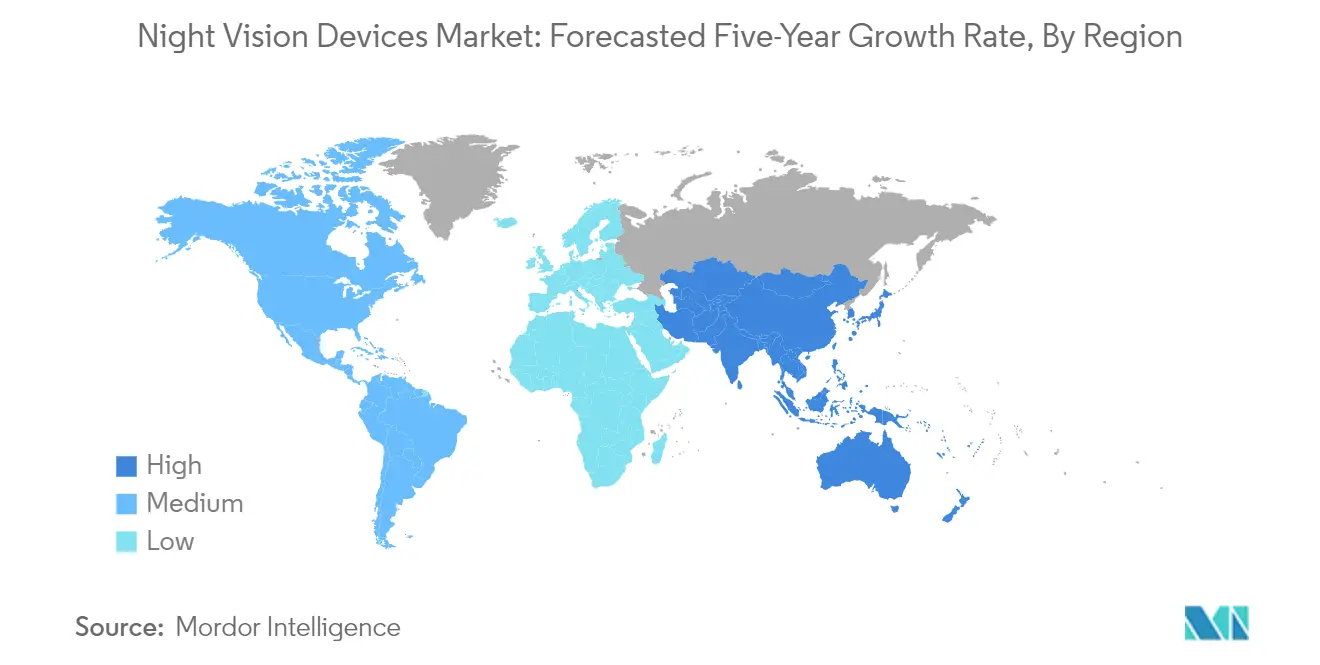
Night Vision Devices Market in Europe
The European night vision devices market has demonstrated robust growth, with an estimated growth rate of around 7% during the period 2019-2024. Countries such as the UK, Austria, Switzerland, and Germany have emerged as key contributors to the region's market development. The market has benefited significantly from government initiatives focused on security, counter-terrorism, and emergency services in regions with low visibility or ambient light conditions. European manufacturers have maintained their position at the forefront of thermal sensor camera design and manufacturing, continuously advancing technology through the development of high-definition thermal sensors. The region's strong focus on research and development has led to breakthrough innovations, including the introduction of organic dye-based devices that enable users to see light waves in the shortwave infrared range. The increasing collaboration between technology providers and defense organizations has further strengthened the market's growth trajectory, particularly in developing advanced night vision systems for military applications.
Night Vision Devices Market in Asia Pacific
The Asia Pacific night vision devices market is poised for exceptional growth, with a projected CAGR of approximately 9% during the period 2024-2029. The region's market dynamics are primarily shaped by increasing defense modernization initiatives and rising government expenditure on military infrastructure. Countries such as China, India, Japan, and South Korea are making significant investments in technological innovation within the night vision sector. The market is witnessing a surge in local manufacturing capabilities, with several manufacturers incorporating high-quality materials and modern technology to produce durable and functional night vision goggles. The presence of strong domestic manufacturing capabilities, coupled with increasing partnerships between international and local players, has created a favorable environment for market expansion. The region's focus on developing indigenous defense capabilities and the growing adoption of night vision technology in various applications, from military operations to wildlife conservation, continues to drive market growth.
Night Vision Devices Market in Latin America
The Latin American night vision devices market continues to evolve, driven by increasing defense modernization initiatives across major economies like Brazil, Argentina, and Chile. The region's market is characterized by growing military expenditure and an increasing focus on enhancing border security capabilities. The adoption of night vision technology has expanded beyond traditional military applications to include law enforcement, wildlife conservation, and commercial security sectors. The market has witnessed significant developments in terms of technological adoption, particularly in integrating advanced night vision capabilities with existing security infrastructure. Regional defense forces are increasingly recognizing the strategic importance of night vision technology in maintaining operational superiority, leading to sustained investments in advanced equipment and training programs. The growing emphasis on modernizing security forces and enhancing surveillance capabilities continues to create new opportunities for market growth.
Night Vision Devices Market in Middle East & Africa
The Middle East & Africa night vision devices market is experiencing steady growth, driven by increasing investments in defense capabilities and security infrastructure. The region's market is characterized by a growing emphasis on incorporating advanced surveillance technologies in both military and civilian applications. Countries across the region are actively modernizing their defense forces with state-of-the-art equipment, including thermal vision cameras, to enhance their operational capabilities. The market has witnessed significant developments in terms of technological adoption, particularly in integrating night vision capabilities with existing security systems. The increasing focus on border security and surveillance has created sustained demand for advanced night vision surveillance system. Furthermore, the growing adoption of night vision technology in commercial applications, including wildlife conservation and industrial security, has opened new avenues for market growth.
Competitive Landscape
Top Companies in Night Vision Cameras Market
The night vision cameras market features prominent players like L3Harris Technologies, BAE Systems, Teledyne FLIR, Thales Group, Elbit Systems, and Raytheon Technologies leading innovation and development. These companies are heavily investing in research and development to enhance their product portfolios with advanced technologies like digital image intensifiers, thermal imaging capabilities, and integrated sensor systems. Strategic collaborations with military and defense organizations have become increasingly common, enabling companies to develop customized solutions while expanding their market presence. The industry witnesses continuous product evolution through the incorporation of artificial intelligence, machine learning, and computer vision technologies to improve detection capabilities and image quality. Companies are also focusing on the vertical integration of their supply chains to better control component quality and reduce dependencies on external suppliers, while simultaneously expanding their global footprint through strategic partnerships and distribution networks.
Market Dominated by Defense Technology Specialists
The night vision cameras market exhibits a relatively concentrated structure, dominated by established defense and aerospace technology conglomerates with extensive military contracts and specialized technological capabilities. These major players leverage their strong relationships with government agencies and defense departments to maintain their market positions, while also benefiting from significant barriers to entry due to the complex nature of the technology and strict regulatory requirements. The market has witnessed several strategic acquisitions and mergers, particularly among companies seeking to enhance their technological capabilities or expand their geographic presence, with larger corporations frequently acquiring innovative smaller firms to strengthen their product offerings.
The competitive dynamics are characterized by a mix of global defense contractors and specialized optoelectronic companies, with regional players focusing on specific market segments or geographic areas. Market consolidation continues to be driven by the need for technological advancement and scale economies, with companies increasingly seeking to combine complementary capabilities through strategic partnerships. The industry's high capital requirements and need for specialized expertise have resulted in a relatively stable competitive landscape, though emerging players from Asia are gradually gaining ground through cost-competitive offerings and growing technological capabilities.
Innovation and Integration Drive Market Success
Success in the night vision cameras market increasingly depends on companies' ability to integrate advanced technologies while maintaining cost competitiveness and meeting stringent quality standards. Incumbent players must continuously invest in research and development to maintain their technological edge, while also expanding their service offerings to include maintenance, training, and system integration capabilities. The ability to develop customized solutions for specific end-user requirements, particularly in the military and law enforcement sectors, has become a crucial differentiator. Companies must also navigate complex regulatory environments across different markets while maintaining strong relationships with government agencies and defense contractors.
For emerging players seeking to gain market share, focusing on niche applications or specific geographic regions provides a viable entry strategy. Success factors include developing cost-effective solutions without compromising on quality, establishing strong local partnerships, and investing in after-sales support infrastructure. The increasing adoption of night vision technology in commercial and civilian applications presents opportunities for new entrants to establish themselves in less regulated market segments. Companies must also consider the growing importance of sustainability and environmental compliance in product development and manufacturing processes, as regulatory requirements become more stringent across global markets.
Night Vision Cameras Industry Leaders
-
Intevac Inc.
-
Photonis (Exosens)
-
Elbit Systems Ltd
-
Rockwell Collins Inc.
-
FLIR Systems Inc.
- *Disclaimer: Major Players sorted in no particular order
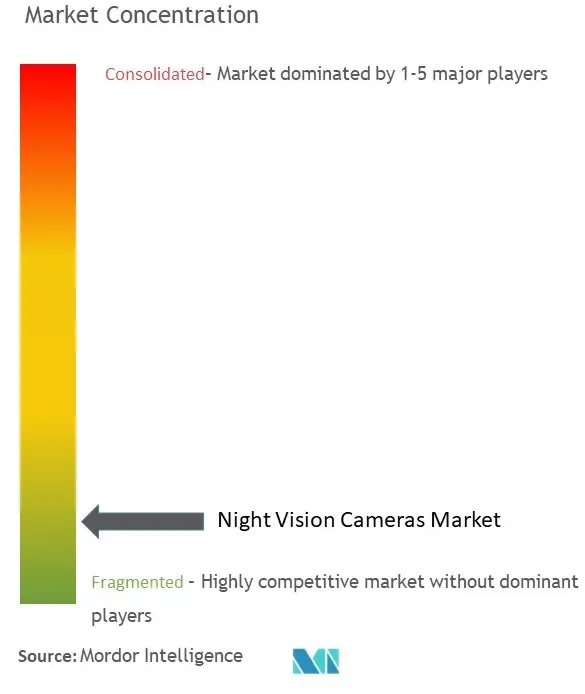
Recent Industry Developments
- February 2024 - Hanwha Vision ushered in a fresh era of accuracy and security in vital sectors through its state-of-the-art, AI-driven radiometric thermal camera series. These advanced devices go beyond conventional security measures by integrating advanced artificial intelligence with temperature detection and high-performance imaging, resulting in unmatched solutions for various applications. AI-based radiometric thermal cameras excel in piercing through darkness and inclement weather, ensuring clear visuals for safe navigation and docking, particularly in nighttime or low-visibility scenarios.
- January 2024 - Deep Sentinel, a security provider, launched its new DS2 wireless security camera system with a superior AI model, higher video resolution, and color night vision. Homes without a security and surveillance system face a higher risk of burglary, thereby increasing the need for innovative, reliable security solutions.
- December 2023 - Thales and the Spanish security company Trablisa formed a joint venture to complete the installation of an integrated surveillance system in the Melilla Command of the Civil Guard for intelligent border control. The surveillance system will enable the Civil Guard with high-resolution day and night cameras. The night vision cameras and the monitoring and control software (HORUS) allow the centralized management and control of sensors and actuators as well as the processing of images.
Global Night Vision Cameras Market Report Scope
Night vision cameras are used to intensify human sight under very low light conditions. The market is segmented on the basis of technology and safety and security measures across different industries, such as manufacturing, services, transportation, military and defense, and automobile.
The night vision cameras market is segmented by type (wired night vision cameras, wireless night vision cameras), end user (military and defense, industrial, public and residential infrastructure, transportation, and research), and geography (North America, Europe, Asia-Pacific, and Rest of the World). The report offers market sizes and forecasts in terms of value (USD) for all the above segments.
| Wired Night Vision Cameras |
| Wireless Night Vision Cameras |
| Military and Defense |
| Industrial |
| Public and Residential Infrastructure |
| Transportation |
| Research |
| Other End Users |
| North America |
| Europe |
| Asia |
| Australia and New Zealand |
| Latin America |
| Middle East and Africa |
| By Type | Wired Night Vision Cameras |
| Wireless Night Vision Cameras | |
| By End User | Military and Defense |
| Industrial | |
| Public and Residential Infrastructure | |
| Transportation | |
| Research | |
| Other End Users | |
| By Geography*** | North America |
| Europe | |
| Asia | |
| Australia and New Zealand | |
| Latin America | |
| Middle East and Africa |
Key Questions Answered in the Report
How big is the Night Vision Cameras Market?
The Night Vision Cameras Market size is expected to reach USD 6.51 billion in 2025 and grow at a CAGR of 11.78% to reach USD 11.35 billion by 2030.
What is the current Night Vision Cameras Market size?
In 2025, the Night Vision Cameras Market size is expected to reach USD 6.51 billion.
Who are the key players in Night Vision Cameras Market?
Intevac Inc., Photonis (Exosens), Elbit Systems Ltd, Rockwell Collins Inc. and FLIR Systems Inc. are the major companies operating in the Night Vision Cameras Market.
Which is the fastest growing region in Night Vision Cameras Market?
Asia Pacific is estimated to grow at the highest CAGR over the forecast period (2025-2030).
Which region has the biggest share in Night Vision Cameras Market?
In 2025, the North America accounts for the largest market share in Night Vision Cameras Market.
What years does this Night Vision Cameras Market cover, and what was the market size in 2024?
In 2024, the Night Vision Cameras Market size was estimated at USD 5.74 billion. The report covers the Night Vision Cameras Market historical market size for years: 2019, 2020, 2021, 2022, 2023 and 2024. The report also forecasts the Night Vision Cameras Market size for years: 2025, 2026, 2027, 2028, 2029 and 2030.
Page last updated on:
